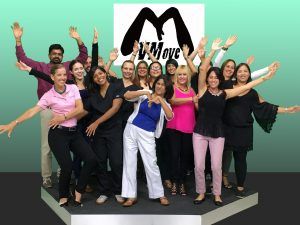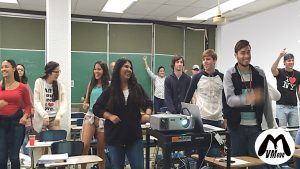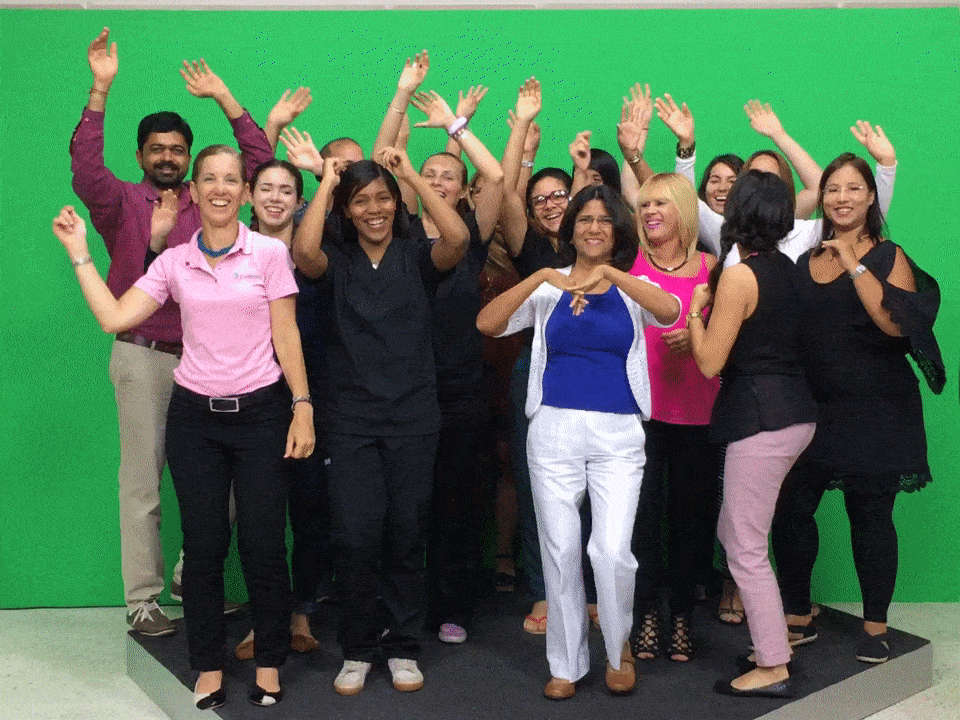 Sometimes the most innovative ideas do not rely on the latest technology but perhaps something far more challenging: changing the norm.
Sometimes the most innovative ideas do not rely on the latest technology but perhaps something far more challenging: changing the norm.
Imagine this scenario. You are attending a fascinating lecture, diligently taking notes, when abruptly the speaker pushes away the microphone and steps from the podium. She requests everyone to rise from their seats and begin to march or hop in place while waving your arms overhead. Your first thought, like most, would likely be bewilderment. You might hesitate and look around at others seated near you. You might chuckle nervously before finally rising out of your chair. Why? Because this is not necessarily perceived as “normal” behavior.
Ready to change this norm, Dr. Kaumudi Joshipura is leading a movement entitled VMove (short for “We Move”), with the slogan: “Activating a Move-Friendly World.” Joshipura demonstrated the above scenario at a TEDx talk, and because she had already explained the concept, the audience was prepared and most rose out of their seats quickly. They moved shyly at first, but as the entire audience participated, it was clear everyone was having fun moving, even within the very limited space!
Moving “Creactively”
We know that a sedentary lifestyle has contributed to epidemic obesity rates as well as other chronic diseases. [1,2] It has been suggested that hours of sitting may be more harmful than smoking because more people sit excessively than smoke. [3] Only about 20 percent of Americans meet CDC recommendations for exercise, which includes engaging in moderate aerobic activity for at least 30 minutes on five days per week, and muscle strengthening at least two days per week. Joshipura affirms following national or international physical activity guidelines, as well as newer guidelines that specifically recommend reducing and breaking sedentary time. [4,5] Research shows that frequent bouts of light activity such as stepping, calf raises, or doing moderate housework offer health benefits of lowering blood sugar and cholesterol. [6,7,8] These spurts of activity can give people a head start on meeting their exercise goals even though they are not performed in a traditional gym setting.
“VMove aims to change the norms and increase the visibility of physical activity in different settings, to inspire and enable more people to engage in physical activity more frequently,” Joshipura explains. “You do not have to don a t-shirt, sweatpants, and sneakers, in order to get moving.”
The VMove concept is simple. Engage in whatever movements you choose, whenever you can, wherever you are. Move for at least a couple of minutes every half hour. In general, more is better, but there are no rules to what the movements are, whether touching your toes, waving your arms overhead, dancing, or doing more conventional workouts such as push-ups. Joshipura calls this “creactivity” (when the activity creatively goes beyond current norms), and hopes that people will frequently break-out into these movements. The VMove website and YouTube channel are aimed to help overcome barriers to moving more, and include videos contributed by people demonstrating spontaneous VMoves in classrooms, offices, supermarket lines, railway stations, and at home while watching television. You may attract stares at first, but Joshipura challenges us all to be leaders of change.
How can you get VMoving and inspire others?
Start moving creactively at home:
- March in place with high knees while talking on the phone
- Dance and do toe taps while preparing food or doing dishes
- Perform lunges, jumping jacks, and pushups during television commercials or move while watching TV
 Share VMove links with people you hang out with regularly such as classmates and coworkers, so you can all move freely together:
Share VMove links with people you hang out with regularly such as classmates and coworkers, so you can all move freely together:
- Set timers for regular short activity breaks at work
- Inspire an organization or unit to adopt VMove
- Move in fun ways together while continuing class or a meeting
Move in settings where you typically wait for several minutes or more: Doctors’ offices, supermarket checkouts, coffee shop lines, train stations, restroom lines at a ball game. Instead of sitting or standing still, start with small movements that will not cause much attention:
- Calf raises, both feet together and then alternating
- Shoulder rolls, in a forward direction and then reverse direction
- Torso twists, swinging the arms side to side
If you feel more bold:
- Overhead arm reaches or big arm circle
- Marching, jogging or hopping in place
- Tapping feet side to side (step touches)
- Plies or squats
- Move freely and have a blast
 Joshipura promotes a universal hand signal/logo for VMove to invite, inspire, and show support of moving creactively across language barriers. The logo may be posted in offices, waiting areas, or classrooms to inspire people to move as feasible, and to encourage acceptance of anyone who chooses to participate.
Joshipura promotes a universal hand signal/logo for VMove to invite, inspire, and show support of moving creactively across language barriers. The logo may be posted in offices, waiting areas, or classrooms to inspire people to move as feasible, and to encourage acceptance of anyone who chooses to participate.
Visit the VMove website for more creactive movement ideas, and to share videos showing how you VMove. You can also help activate a move-friendly world by spreading the word about VMove on social media, using the hashtag #VMove.
Related

Photos courtesy of VMove
References
- Wilmot, E.G., et al. Sedentary time in adults and the association with diabetes, cardiovascular disease and death: systematic review and meta-analysis. Diabetologia, 2012. 55: p. 2895-905.
- Dunstan, D.W. et al. Too much sitting – A health hazard. Diabetes Res Clin Pract, 2012. 97(3): p. 368-76.
- Levine, J.A. The Chairman’s Curse: Lethal Sitting. Mayo Clin Proc, 2014. 89(8): p. 1030-2.
- American Diabetes Association. Be More Active Throughout the Day. 2013. Retrieved from http://www.diabetes.org/food-and-fitness/fitness/types-of-activity/be-more-active-throughout-the-day.html
- Australian Government Department of Healthy. Australia’s Physical Activity and Sedentary Behaviour Guidelines. 2014. Retrieved from http://www.health.gov.au/internet/main/publishing.nsf/content/health-pubhlth-strateg-phys-act-guidelines.
- Dunstan, D.W., et al. Breaking Up Prolonged Sitting Reduces Postprandial Glucose and Insulin Responses. Diabetes Care, 2012. 35(5): p. 976–83.
- Manohar C. et al. The effect of walking on postprandial glycemic excursion in patients with Type 1 diabetes and healthy people. Diabetes Care, 2012. 35: p. 2493–9.
- Healy G.N., et al. Replacing sitting time with standing or stepping: associations with cardio-metabolic risk biomarkers. Eur Heart J, 2015. 36(39): p. 2643-9.